|
|
|
This page contains the following further information for enriched lives:
|
USEFUL LINKS
ABS Census of Population and Housing
ABS Topics @ a Glance - Family and Community Statistics
ABS Topics @ a Glance - Aboriginal and Torres Strait Islander Peoples
ABS Topics @ a Glance - Sport and Physical Recreation
ABS Topics @ a Glance - Culture
ABS General Social Survey: Summary Results, Australia, 2010 (cat. no. 4159.0)
ABS How Australians Use Their Time, 2006 (cat. no. 4153.0)
ABS Participation in Sport and Physical Recreation, Australia, 2011-12 (cat. no. 4177.0)
ABS Attendance at Selected Cultural Venues and Events, Australia, 2009-10 (cat. no. 4114.0)
ABS Participation in Selected Cultural Activities, Australia, 2010-11 (cat. no. 4921.0)
ABS National Survey of Mental Health and Wellbeing: Summary of Results, 2007 (cat. no. 4326.0)
ABS Cultural Diversity in Australia - Reflecting a Nation: Stories from the 2011 Census, 2012-13 (cat. no. 2071.0)
ABS Spectator Attendance at Sporting Events, 2009-10 (cat. no. 4174.0)
|
GLOSSARY
Activities
The description of particular tasks that were being done during a person's day.
Attendance rate
For any group, this is calculated by expressing the number of people who attended a venue or event at least once during the year as a percentage of the population aged 15 years and over in the same group.
Cultural activity
A cultural activity has been defined as an activity in which a person has participated, which has not been done for secondary or tertiary studies. It excludes activities with no creative aspect such as mending or repairing clothes and home do-it-yourself (DIY) projects. Respondents were asked whether they participated in each of the selected cultural activities listed below, in the 12 months before interview:
- drama, comedy, opera or musical, including rehearsals (including acting for stage or film, street theatre and stand-up comedy);
- cabaret or variety act, including rehearsals (including circus performance/acts, rehearsals and classes specific to the performance and informal practice or preparation for a performance;
- singing or playing a musical instrument as a soloist or as part of a band, choir or orchestra, including rehearsals and classes (including singing for which the respondent has practised or taken lessons, and singing or playing in a public forum with an audience e.g. church choir, performing at an aged care facility or retirement home. Excludes informal or impromptu singing such as around the home or karaoke;
- dancing, including rehearsals or classes (including dancing for which the respondent has practised or taken lessons. Excludes dancing for another performance such as singing in a band and informal or impromptu dancing such as at weddings or nightclubs);
- writing song lyrics or mixing or composing music, including digital composition;
- writing any fiction or non-fiction such as stories, poetry or scripts (including blogs but excluding Twitter, Facebook and Myspace profile updates);
- sculpting, painting, drawing or cartooning, including digital pieces;
- printmaking, screen printing or etching;
- textile crafts, jewellery making, paper crafts or wood crafts (including knitting, embroidery, quilting, dress making or tailoring, cross stitch or tapestries, appliquè, beading, scrapbooking, making cards and collage. Excludes mending or repairing clothes and maintenance and repair);
- glass crafts, pottery, ceramics or mosaics;
- photography, film-making or editing, apart from personal events (excluding acting in a film, scriptwriting and use of video or DVD as a tool in another activity);
- designing websites, computer games or interactive software (excluding contributing to websites designed by other people or organisations, posting videos on YouTube, creating profiles on Myspace or Facebook or creating pages on similar websites. Also excludes creating web journals or blogs);
- fashion design, interior or graphic design (excluding home DIY projects); and
- other digital art or craft not already reported.
Employed
All persons aged 15 years and over who, during the reference week:
- worked for one hour or more for pay, profit, commission or payment in kind in a job or business, or on a farm (comprising employed, employers and own account workers); or
- worked for one hour or more without pay in a family business or on a farm (i.e. contributing family workers); or
- were employed who had a job but were not a work and were:
- away from work for less than four weeks up to the end of the reference week; or
- away from work for more than four weeks up to the end of the reference week and received pay for some or all of the four week period to the end of the reference week; or
- away from work as a standard work or shift arrangement; or
- on strike or locked out; or
- on workers' compensation and expected return to their job; or
- were employed or own account workers, who had a job, business or farm, but were not at work.
Full-time workers
Employed persons who usually worked 35 hours or more a week (in all jobs) and those who, although usually working less than 35 hours a week, worked 35 hours or more during the reference week.
Household
One or more persons usually resident in the same private dwelling.
Labour force status
A classification of the civilian population aged 15 years and over into employed, unemployed or not in the labour force, as defined. The definitions conform closely to the international standard definitions adopted by the International Conferences of Labour Statisticians.
Main English-speaking countries
The list of main English-speaking countries (MESC) provided here is not an attempt to classify countries on the basis of whether or not English is the predominant or official language of each country. It is a list of the main countries from which Australia receives, or has received, significant numbers of overseas settlers who are likely to speak English. These countries comprise the United Kingdom, the Republic of Ireland, New Zealand, Canada, South Africa and the United States of America. Non-MESC describes people originating from countries where a language other than English is likely to be spoken by migrants. It is important to note that being from a non main English-speaking country does not imply a lack of proficiency in English.
Not in labour force
Persons who were not in the categories employed or unemployed as defined.
Participation rate
The number of people who participated in an activity at least once during the year as a percentage of the population aged 15 years and over.
Part-time workers
Employed persons who usually worked less than 35 hours a week (in all jobs) and either did so during the reference week, or were not at work in the reference week.
Recreation and leisure activities
A major activity classification group which includes activities such as playing sport, walking, participating in games or hobbies, reading and watching television. Also included is other free time such as relaxing, thinking, smoking and drinking alcohol.
Social and community interaction
A major activity classification group which includes activities relating to social interaction participation such as attending a concert, a library or amusement park. Also included are attending sports events, participating in religious ceremonies and community participation such as attendance at meetings.
Unemployed
Persons aged 15 years and over who were not employed during the reference week, and:
- had actively looked for full-time or part-time work at any time in the four weeks up to the end of the reference week and were available for work in the reference week; or
- were waiting to start a new job within four weeks from the end of the reference week and could have started in the reference week if the job had been available then.
|
|
There are no references for this theme
|
Click on the links below to be taken to a summary of the graphs from the corresponding tab within the Enriched lives theme:
Giving
Time and opportunity
Recreation and sport
Popular culture and the arts
|
| GIVING |
 |
People that provided unpaid help to others living outside the household(a) |
 |  |  |
 |  |  |
Progress indicator |  | ...by sex |

Footnote:
(a) Persons aged 18 years and over.
Source:
ABS General Social Survey: Summary Results, Australia (cat. no. 4159.0) |  | 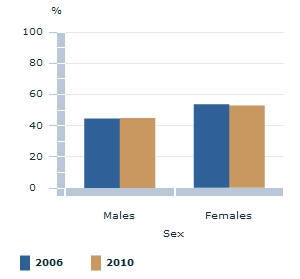
Footnote:
(a) Persons aged 18 years and over.
Source:
ABS General Social Survey: Summary Results, Australia (cat. no. 4159.0) |
 |  |  |
 |  |  |
 |  |  |
...by age |  |  |

Footnote:
^ Estimates for 75-84 year age group in 2010 and 85 years and over age group in 2006 have relative standard errors of 10% to less than 25% and should be used with caution.
* Estimate for 85 years and over age group in 2010 has a relative standard error between 25% and 50% and should be used with caution.
(a) Persons aged 18 years and over.
Source:
ABS General Social Survey: Summary Results, Australia (cat. no. 4159.0) |  |  |
 |  | |
 |  |  |
 |  |  |
|
| TIME AND OPPORTUNITY |
 |
Average time spent on recreation and leisure activities, and social and community interaction(a) |
 |  |  |
 |  |  |
Progress indicator |  | ...by sex |

Footnote:
(a) Persons aged 15 years and over.
Source:
ABS How Australians Use Their Time (cat. no. 4153.0) |  | 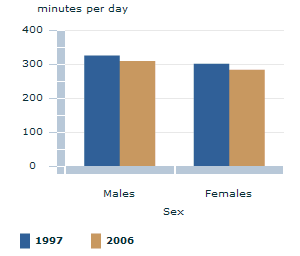
Footnote:
(a) Persons aged 15 years and over.
Source:
ABS How Australians Use Their Time (cat. no. 4153.0) |
 |  |  |
 |  |  |
 |  |  |
...by recreation and leisure activities |  | ...by social and community interaction |

Footnote:
(a) Persons aged 15 years and over.
Source:
ABS How Australians Use Their Time (cat. no. 4153.0) |  | 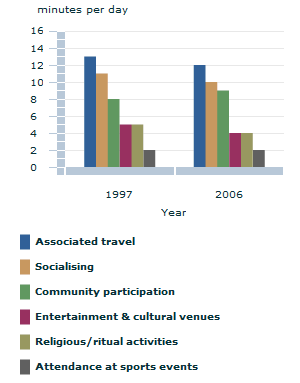
Footnote:
(a) Persons aged 15 years and over.
Source:
ABS How Australians Use Their Time (cat. no. 4153.0) |
 |  | |
 |  |  |
 |  |  |
|
| RECREATION AND SPORT |
 |
Participation rate for sport & physical recreation(a)(b) |
 |  |  |
 |  |  |
Progress indicator |  | ...by sex |

Footnote:
(a) Persons aged 15 years and over.
(b) In the last 12 months.
Source:
ABS Participation in Sport and Physical Recreation, Australia (cat. no. 4177.0) |  | 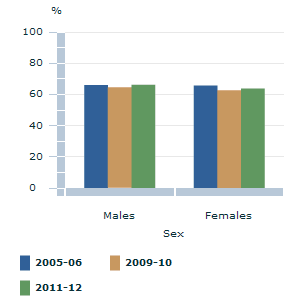
Footnote:
(a) Persons aged 15 years and over.
(b) In the last 12 months.
Source:
ABS Participation in Sport and Physical Recreation, Australia (cat. no. 4177.0) |
 |  |  |
 |  |  |
 |  |  |
...by age |  | ...by state and territory |

Footnote:
(a) Persons aged 15 years and over.
(b) In the last 12 months.
Source:
ABS Participation in Sport and Physical Recreation, Australia (cat. no. 4177.0) |  | 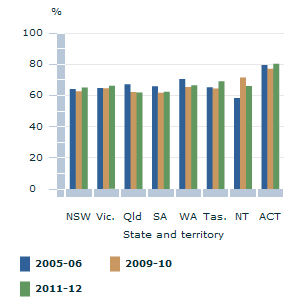
Footnote:
(a) Persons aged 15 years and over.
(b) In the last 12 months.
Source:
ABS Participation in Sport and Physical Recreation, Australia (cat. no. 4177.0) |
 |  | |
 |  |  |
 |  |  |
|
| POPULAR CULTURE AND THE ARTS |
 |  |  |
Popular culture and the arts(a) |
 |  |  |
 |  |  |
Progress indicator - Attendance rate |  | Attendance rate, by venue or event |

Footnote:
(a) Persons aged 15 years and over.
(b) At least once in the last 12 months.
(c) Attendance at cultural venues or events.
Source:
ABS Attendance at Selected Cultural Venues and Events, Australia (cat. no. 4114.0) |  | 
Footnote:
(a) Persons aged 15 years and over.
(b) At least once in the last 12 months.
(c) Attendance at cultural venues or events.
Source:
ABS Attendance at Selected Cultural Venues and Events, Australia (cat. no. 4114.0) |
 |  |  |
 |  |  |
 |  |  |
Progress indicator - Participation rate - 2010-11 |  | Participation rate, by age - 2010-11 |
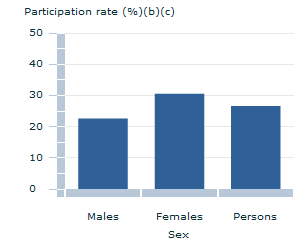
Footnote:
(a) Persons aged 15 years and over.
(b) In the last 12 months.
(c) Participation for selected cultural activities.
Source:
ABS Participation in Selected Cultural Activities, Australia, 2010-11 (cat no. 4921.0) |  | 
Footnote:
(a) Persons aged 15 years and over.
(b) In the last 12 months.
(c) Participation for selected cultural activities.
Source:
ABS Participation in Selected Cultural Activities, Australia, 2010-11 (cat no. 4921.0) |
 |  | |
|
|
|
|